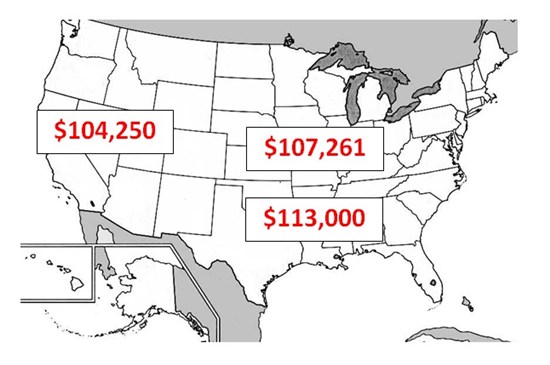OD-employees do best in the South, according to Jobson Optical Research’s and Local Eye Site’s 2013 ECP Compensation Study. The average compensation for optometrist-employees overall is $107,977, but in the South the average compensation of optometrist-employees is $113,000. In the Midwest the average is $107,261 and in the West it is $104,250.
Click HERE to purchase Jobson Optical Research’s and Local Eye Site’s 2013 ECP Compensation Study.
How much money does an employee optometrist (EOD) need to generate in order to justify the average compensation of $107,977? You need to know if you are paying your employee optometrists too much or just the right amount. Let’s work our way through the numbers to see what is happening in your practice.
First, let’s assume that we are going to pay 20 percent of the total revenue generated by the employee optometrist to the employee optometrist. To answer that question of how much does the employee optometrist need to generate, we need to solve the following equation: (EOD) x .2 = $107,977. The answer is $539,885. Twenty percent of $539,885 is $107,977.
 Where did the .2 come from you ask? It is an arbitrary number. The most you should pay for all your optometrists is 20 percent of the total number of dollars generated by the practice by any means.
Where did the .2 come from you ask? It is an arbitrary number. The most you should pay for all your optometrists is 20 percent of the total number of dollars generated by the practice by any means.
The “optometric net” in a practice is calculated by adding the income from all optometrists–employee and employer–in a practice with the “true net.” The “true net” is defined as what is left over after paying all expenses including all optometrists.
According to the MBA data, the median “optometric net” is 30 percent. To divide that up for the median practice would mean, if we paid all the optometrists in that practice from a bucket that contains 20 percent of the gross revenue, then that leaves 10 percent to go into a bucket to pay the owners of the practice above and beyond any optometric work done.
To be very clear, we are not paying each optometrist in the practice 20 percent of the gross revenue. We are paying all the optometrists in the practice out of a bucket that contains 20 percent of the gross revenue. Let’s look at some numbers to help here. If the practice gross revenue is $1 million, then 20 percent of that number gives us $200,000 to pay all the optometrists in the practice. If there is one optometrist, then that person gets the entire amount. If there are two optometrists each working an equal number of clinical hours, then they would split the $200,000 between them 50-50 with each getting $100,000. If Dr. A works 40 hours a week and Dr. B works 30 hours a week, then in our example, Dr. A receives 40/70 x $200,000 = $114,286 while Dr. B receives 30/70 x $200,000 = $85,714.
Now, instead of paying all the optometrists out of a bucket containing 20 percent, could we pay them 17 percent? Absolutely. If you can negotiate a lower amount than 20 percent, then the difference between the amount you negotiate and 20 percent drops straight down to the “true net” of the practice. The opposite is also true. Every percentage point over 20 percent is coming out of the owner’s “true net.”
To completely understand this situation, we need to ask: Does the $107,977 include benefits such as health care, malpractice insurance, continuing education, paid vacation, sick leave, license renewal, etc? If it does, then the formula determining how much the EOD needs to generate is correct. If the benefit package is a separate item, then the cost for the EOD is going to be higher and that means the amount of money the EOD must generate is higher.
Your action plan for this week is to take the following three steps:
1) Calculate the total compensation package for each employee optometrist in your practice.
2) Calculate how much revenue they must generate to cover that compensation package.
3) Make sure they are at least generating the minimum amount needed to cover their total compensation package.
Going through this exercise gives you a path to follow when the employee OD asks for a raise. The answer is simply, help the practice increase its gross revenue and we can share that increase with you. If you believe in transparent management, as we do, then you can share the calculations with the employee OD.



























